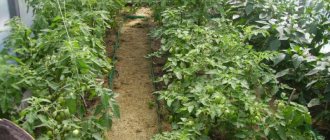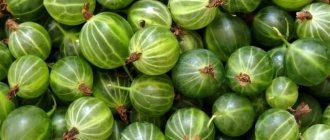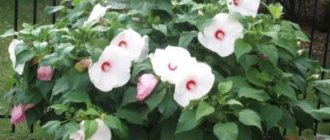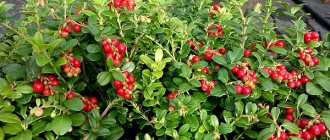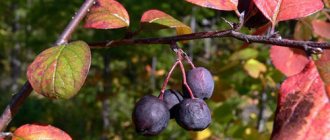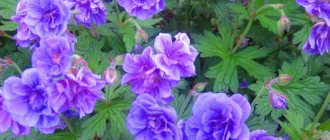Where do blueberries grow in nature?
In nature, the low-growing shrub, which sheds its leaves in the winter, grows in swampy areas and easily tolerates cold winters. Wild blueberries can be found in the forests of the northern hemisphere - from California to Alaska, in North America and from Mongolia to Iceland in Eurasia, where the berry reproduces well and produces a good harvest.
Description
The common blueberry belongs to the Heather family (lingonberries, cranberries, blueberries), loves acidic soils and grows in swampy swamps, and can often be found on mountain slopes. The bush with erect shoots of a dark gray hue and young branches painted green does not exceed 1 m in height, and some tall varieties grow up to 2 m. The root system of the plant does not have thin lateral roots and is fibrous in structure.
Did you know? More than 20 festivals a year presenting and selling blueberry dishes are held in Canada and the United States.
The leaves have a greenish-blue tint and are covered with a waxy coating on top. The shape of the leaf is elongated and resembles an egg, as it expands downwards. Hard, dense leaf plates are arranged alternately and are attached to short cuttings. The length of the leaf can reach up to 3 cm, and the width with the stalk - up to 2.5 cm. The veins stand out only on the reverse side of the leaf, where its color is pale green.
Spring flowering begins on one-year-old branches, small flowers with five petals collected in several pieces. The soft pink or white corolla resembles a jug, covered with stamens, of which there can be up to 19 pieces. The fruits are oblong in shape, up to 12 mm long and weigh on average 1 g. The blue berries are covered with a bluish coating with a thin skin. The pulp is dense and has a pale green color.
Medium ripening varieties
The varieties included in this group ripen in the third ten days of July and until the first half of August. We will describe the most popular and in demand.
Blueberry Sierra
The fruits are large and slightly flattened. The berries are aromatic, sweet and juicy, consumed raw, and also used for preparing winter preparations. The bush grows up to 2 meters high and has strong branches. The foliage is quite large; in the fall the greenery takes on a red tint.
Flowering occurs in May, and fruit ripening occurs at the end of July. The yield is 3-4 kg per bush . The plant tolerates frosts down to -26 degrees.
Blueberry Bluecrop
The most common industrial variety, which is considered a kind of standard for the entire species. It is distinguished by its endurance, good yield, and unpretentiousness to environmental conditions. Even novice gardeners can grow Bluecrop.
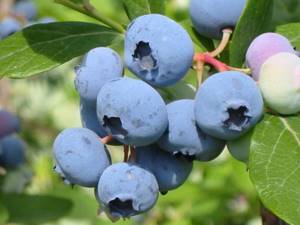
The bushes grow up to 1.9 m in height. The berries are large up to 2 cm in diameter, the skin is bluish. The fruits are sweet with a slight sourness, pleasant to the taste. They ripen in mid-July, but not evenly. They can withstand transportation without cracking.
Fruiting begins in the third year of the plant's life. Productivity is in the range of 6-9 kg. To increase performance, it is recommended to prune the bush abundantly every year. Frost resistance down to -34 degrees.
Blueberry Denis Blue
An Australian breeder developed this blueberry variety and received high marks all over the world. It is grown both in Europe and North America. The berries ripen simultaneously at the end of July and beginning of August. The fruits have a diameter of up to 19 mm, the yield is no more than 8 kg per bush. The berries retain their presentation and properties for 2 weeks.
The bush grows 1.5-1.8 meters in height and has an attractive appearance all season long. Stable fruiting is observed from the third year. Denis Blue is resistant to most diseases, incl. fungal, withstands frosts down to -34 degrees.

Blueberry Northblue
Low-growing bushes grow up to 60-90 cm and are used both for harvesting and for decorative garden decoration. This is one of the most frost-resistant varieties; it can withstand cold down to -40 degrees. North blue is a hybrid of highbush and narrowleaf blueberries native to Canada.
Productivity is at the level of 3.5 kg. The berries are up to 18 mm in diameter, the skin is blue, the flesh is dense, the taste is good. Low yield is a minor drawback compared to the compactness of the plant, its unpretentiousness and resistance to negative environmental factors.
Blueberry and gonobobel - are they the same thing or not?
There are many different names for forest shrubs - blue grapes, drunkard, fool's tree, confused with wild rosemary, which grows next to blueberries. But the most common name is gonobobel. Hearing this name, many wonder whether this plant is the same or has a completely different appearance. Gonobobel is a tall blueberry variety. The fruits on the bush are rich blue in color, larger in size and weight than wild berries.
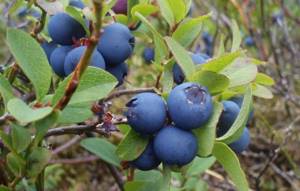
The bush looks impressive in the garden from the moment of flowering until the autumn leaves fall. In terms of its taste and chemical composition, it is no different from low-growing varieties. If you are offered to buy gonobobel for your garden, do not doubt that this is a tall type of blueberry, which will delight you not only with a rich complex of vitamins and minerals, but will also give an excellent harvest.
Garden blueberry Bluecrop (Blyukrop)
| The mid-season blueberry variety Bluecrop is still one of the main varieties for our regions. It was bred in the Netherlands, which also does not have many warm sunny days. Bluecrop garden blueberry is the most famous and respected variety, to which all cultivated varieties are compared. The bushes grow 1.6 m high. This variety is characterized by large berries of very good quality, suitable for manual and mechanical harvesting (especially late harvest). Bluecrop blueberries have excellent taste characteristics and are suitable for fresh consumption and storage. The berries give a high yield of up to 4 kg per bush. The bushes grow quickly even in moderate drought conditions. Bluecrop blueberries are a moderately early variety, high-yielding, suitable for commercial production and households. Prefers dry soils; in heavy and wet soils it is more susceptible to diseases of the stem and roots. One of the most resistant varieties to spring frosts. |
Varieties of varieties
Given the great popularity of berries in North America, Americans began to select new varieties at the beginning of the 20th century. The genetic material was an ordinary low-growing species of blueberry.
Did you know? Low-bush blueberries have higher levels of antioxidants contained in the skin than high-bush varieties.
At the moment, the result of the work of breeders in the USA, Scandinavia, and Canada are numerous types of blueberries, which can be divided into groups:
- Low-growing - the height of the bush is low (up to 0.5 m), the berry is small in size. It has one drawback - the difficulty of propagation and the expensive cost of planting plantations.
- Tall northern varieties have late flowering periods and can withstand harsh, frosty winters. Due to the late flowering period, the berries may not have time to ripen.
- Tall southern - bred from plants growing in the south and crossed with northern species. They tolerate heat well and are grown in the southern regions.
- Semi-tall - winter-hardy varieties up to 1 m high, do not freeze out thanks to snow cover.
- Rabbit's eye - bushes can grow up to 2.5 m, are unpretentious to the composition of the soil, the berries do not fall off, but the taste is inferior to other groups and has a late ripening period.
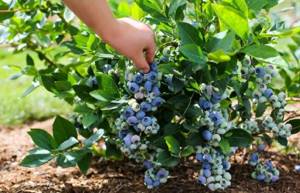
When growing blueberries in your garden, choose a variety suitable for your climate zone.
Bloom
In early May, blueberries begin to bloom. On last year's shoots, 4–5 vegetative buds are formed and white or light pink flowers bloom . The first flowering occurs 2–3 years after planting a young plant. In the first year the flowering is not abundant, but in subsequent years the bushes are completely covered with flowers. There can be up to 40 peduncles on one fruit branch.
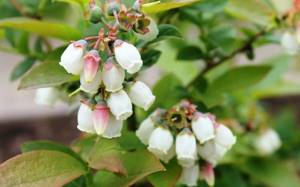
What does the taste taste like?
Blueberries are often confused with blueberries. In color, shape and almost taste, the aromatic, moderately sweet berry resembles blueberries. Fleshy pulp, with light green juice, tastes a little sour. Almost like blueberries, only without the cloyingly sweet aftertaste.
You will be interested in reading how to grow blueberries in the Krasnodar region.
Early varieties
Early ripening blueberry varieties open the season starting in mid-July. Let's look at the most popular of them.
Blueberry Duke
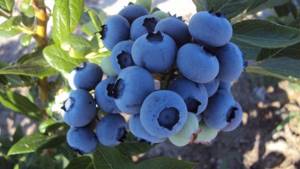
The variety was bred in America more than 30 years ago. This is a popular variety that provides high yields. The berries ripen quickly and smoothly. The bush grows to a height of 1.2-1.8 meters and is resistant to temperatures down to -30 degrees. The plant is not recommended to be placed in cold areas with high humidity.
Duke blooms quite late, and the berries ripen early. This factor helps protect the plant from spring frosts. In total, it takes 45 days to flower and ripen the berries, which is a kind of record among other types of blueberries.
The bush produces 6-8 kg of harvest. The berries do not exceed 2 cm in diameter and weigh 2.5 g. The taste is tart-sweet with sourness. The pulp is dense, greenish. It is better to pick the fruits by hand; they tolerate transportation well and are preserved for a long time.
Blueberry Chanticleer
Tall variety with an early ripening period. The berries reach ripeness almost simultaneously and 1-2 weeks earlier, compared to Duke blueberries. The height of the bush is 145-160 cm. Harvesting is convenient - the fruits are in clusters on the outside of the plant.
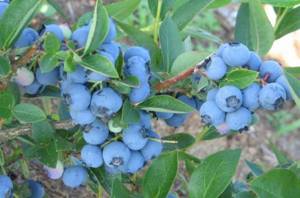
The berries weigh 1.8-1.9 g and are light blue in color. The taste is pleasant, sweetness is expressed with slight notes of sourness, the internal structure is dense. The berries are stored for a long time and are easily transported; on an industrial scale they tolerate mechanized harvesting.
The variety is resistant to moniliosis, anthracnose and other major diseases. Winter hardiness is at -28 degrees.
Blueberry Patriot
The variety has been grown for more than 40 years and is loved by many due to the large size of the berries. Their weight can reach 4 grams. The fruits are juicy with dense greenish flesh and a pleasant taste. The harvest begins to ripen in mid-July . The bush grows up to 1.8 m and begins to bear fruit steadily from the third year of life. One plant produces up to 10 kg of berries.
Frost resistance -40 degrees. Patriot is immune to most diseases. Prefers to be in well-lit areas without strong gusts of wind and drafts. However, bushes also grow in less favorable places with high humidity. Harvesting by hand or machine.
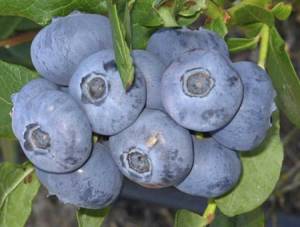
Blewett's blueberry
The description of the variety usually does not make a very good impression, but in fact, Blyuetta pleases with its beautiful and early-ripening berries and provides a decorative effect for the garden. The bush is squat with a compact crown, grows up to 0.9-1.5 meters. Fruit ripening occurs in the second decade of July (the whole process takes no more than 50 days) and occurs in 3-4 waves.
The berries are dark blue in color and medium in size, not exceeding 11 mm in diameter. The pulp is greenish with a pink tint, dense. The skin is thin, the taste is acceptable. The variety is often used for home rather than industrial cultivation. Fruits can be transported no later than 18 days after collection. Productivity from one bush is 4.5-7 kg.
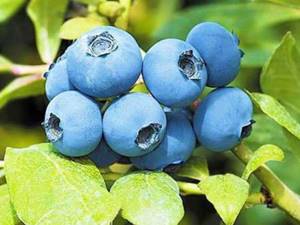
Blueberry Northland
It has been grown in gardens for more than 50 years, has a stable yield of 4-8 kg per bush, and is disease-resistant. The berries ripen in mid-July and are stored for a long time. Small in size, but dense and sweet. The fruits are well suited for baking and making jams.
The bush grows up to 1.2 m in height, is of decorative value and needs annual pruning. The variety is resistant to frost down to -40 degrees. The growing season is short, which allows it to be grown even in northern regions.
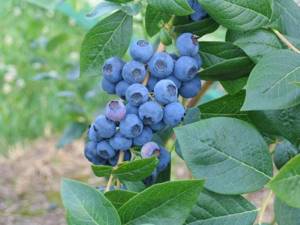
Blueberry Hannah Choice
The variety is resistant to spring frosts down to -7 °C and winter frosts down to -39 °C. The berries are medium and large in size, on average 15-17 mm in diameter, but giants up to 30 mm can also be found. Ripening begins in mid-July, the fruits do not fall and hang on the bush for a long time. The berry tastes sweet, with dense pulp and a pleasant aroma. It is used for fresh consumption, baking, and canning. The harvest can be transported without problems and stored for a long time. 4-5 kg are collected from one plant.
The bush grows 1.5-2.1 meters high. Planted in sunny areas with acidic soil. Fruiting begins in the third year, productivity gradually increases. No pollinators required.
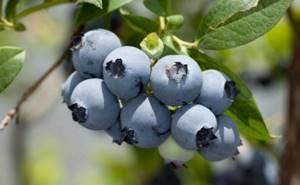
Planting and caring for blueberries
Knowing about the beneficial properties of the fruit, many amateur gardeners practice growing blueberries in their summer cottages. Seedlings can be planted in early spring and autumn.
In the spring, having chosen a well-lit area protected from the wind with acidic soil (pH 3.5–4.5), you can begin planting:
- The prepared material is planted in a hole 50 cm deep and 60 cm in diameter.
- To create acidic soil, a mixture of sand, peat, pine needles, sawdust with the addition of 50 g of sulfur is poured into the pit. The composition should be loose so as not to damage the fragile roots.
- The roots are carefully distributed over the entire diameter of the hole.
- After sprinkling with soil, deepen the root collar by 3 cm, lightly press down around the bush, and water.
- To retain moisture, mulch the surface.
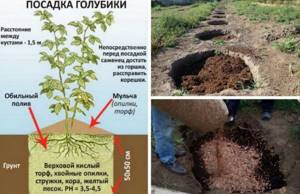
When planting seedlings in the fall, follow the rules of spring planting; the only thing that needs to be done at this time is to cut off weak branches and shorten the rest by 50%. This will allow the plant to take root faster and survive the winter more easily.
Planting garden and common blueberries is no different; the only condition is the distance between the seedlings in the same row:
- low-growing varieties - at least 50 cm;
- medium-sized - up to 100 cm;
- tall - 120 cm.
Important! When insulating a blueberry bush for the winter, do not use sawdust, as the heat it generates can cause the plant to rot.
It is better to purchase seedlings in a container with soil. 10-15 minutes before disembarking. hold in water so that the lump of earth softens and does not damage the young roots. The plant does not require special care. Moderate watering, removing weeds, pruning old, damaged branches, fertilizing - this is the entire list of tasks for the blueberry care season.
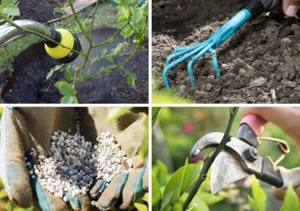
It is better not to use organic fertilizers, as they reduce the acidity of the soil. Several times a season you need to loosen the soil, giving oxygen access to the roots. To maintain the required level of acidity, the plant can be watered with a solution of apple cider vinegar (1:3) and tested with litmus paper.
Reasons to grow blueberries
To finally make sure of the need to plant the plant on your site, we recommend that you familiarize yourself with the positive aspects of growing blueberries:
- Delicious berries that taste similar to blueberries, but are larger, juicier and sweeter.
- High yield - up to 10 kg of fruits are harvested from one bush.
- Berries contain useful and biologically active components.
- The fruits are consumed raw, and are also used to make jam, baked goods and other dishes.
- The plant does not require special care, is immune to most diseases, and is rarely affected by pests.
- Blueberries are resistant to negative temperatures. Some varieties can survive frosts down to -40 degrees.
- The plant becomes not only a means of harvesting, but also has decorative value for the garden. In the spring, the bush blooms beautifully, in the summer it pleases the eye with berries, and in the fall the color of the leaves changes from green to crimson. Blueberries easily tolerate pruning and are sometimes used as a hedge.
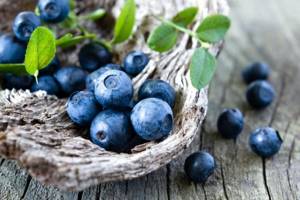
Blueberries in landscape design: blueberry hedge
Delicate blooms in the spring, blue berries in the summer, red leaves in the fall - blueberries that vary throughout the season can be perfectly used in landscape design. Tall varieties surround the garden plot like a hedge, while low-growing varieties easily fit in large pots and set the basis for the intended composition, and a free-standing plant also looks original.
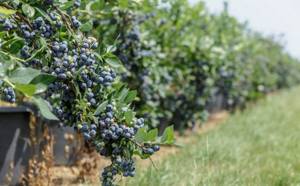
Soft pink, and in some varieties bright pink, bushes abundantly covered with flowers attract attention in the spring; deep blue berries hanging on a green background of foliage not only decorate the garden in the summer, but also benefit the body; the autumn color of the foliage is also beautiful. This suggests that blueberries are a universal plant for design ideas for landscaping.
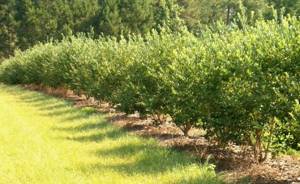
Many gardeners use the plant on the site as a hedge, planting both low-growing varieties and tall plants. A number of low-growing varieties are planted at a distance of up to 0.5 m from each other and look like a low (up to 1 m) living fence. Tall varieties and the Rabbit Eye group are allowed on trellises. This hedge looks impressive and reaches up to 2–2.5 m in height.
Bluegold garden blueberry
| Bluegold garden blueberries are mid-season varieties. It has low bushes up to 1.2 m tall. The bushes are quite spreading and have a large number of stems, which requires pruning. Bluegold blueberries are medium sized. They are characterized by early coloring, but without an increase in sugar content, they can also fall off before harvesting. Manual collection is recommended. Keeps well when properly refrigerated in a controlled atmosphere. Bluegold blueberries ripen in the first half of August. It is an important variety due to its late ripening season, high yield and good taste. Unpretentious, recommended for beginner gardeners who do not want to spend time caring for and planting blueberries. |
Pests and their control
Like any plant, blueberries are susceptible to diseases and attacks by beetles and butterflies, which cause irreparable damage to shoots, leaves, and fruits:
- Roseate and black-headed leafrollers - butterflies harm young plants, laying larvae on the bark of shoots for the winter, and in the spring, when the sun warms the air, caterpillars appear, actively eating buds and flowers. Wrapping the young leaves in a web, they roll them up into a tube, plunging into a state of rest until a new butterfly flies out.
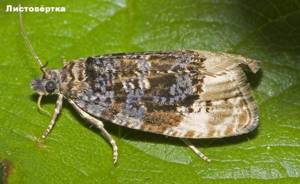
- Grape pipe grinder - a beetle whose young larvae damage buds and foliage.
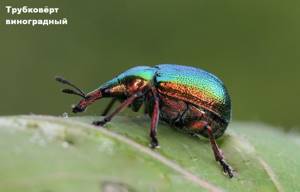
- Fruit moth - like any butterfly, it lays larvae on the buds, from which pink caterpillars emerge, damaging the fruits.
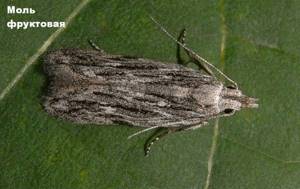
- Western May Khrushchev - a beetle that eats leaves until it grows a shell.
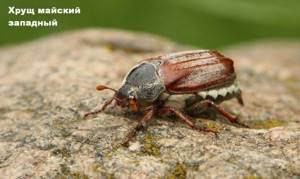
- Kidney mite — the larvae eat the buds in the spring and are carriers of viral diseases.
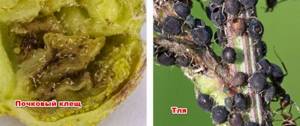
- Black beet and red blood aphids are carriers of bacteria and fungal diseases, slow down the growth of young plants, and the fruits become small.
- Skosar single - a black beetle whose larvae feed on roots.
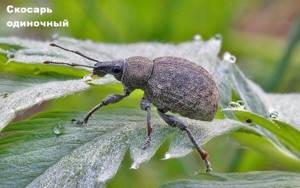
- Comma-shaped scale - insect, larvae feed on plant cell sap.
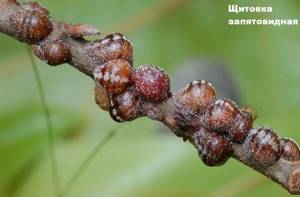
Autumn-spring prevention will help prevent pests from eating the plant in the spring, but if you didn’t have time and the bush is suffering from caterpillars or beetles, take insect control measures:
- from leaf rollers and May beetle, use light traps, loosening the soil, pruning leaves with embedded larvae, or treat the bush with the preparations “Desant”, “Atom”;
- Autumn prevention and spring treatment with Metaphos will help against the tubeworm;
- fruit moths are removed by treatment in two stages with the preparations “Lepidocid” and “Bitoxibacillin”;
- spraying bushes with copper sulfate in early spring will help cope with bud mites;
- for aphids, use the preparations “Calypso 480” and “BI-58”;
- spring treatment of the buds with “Rogor” will prevent the larvae of the solitary mower from multiplying;
- shoots affected by scale insects are treated with “Karbofos” or “Decis”.
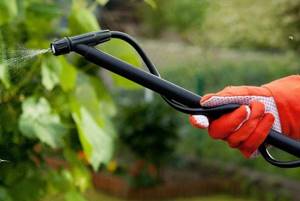
Blueberries have many pests, but timely prevention and treatment with drugs reduce the risk of insect attacks on the plant.
Prevention of blueberries
Many enemies of blueberries begin to lay larvae in fallen leaves or soil in the fall, so prevention should begin with harvesting leaves and loosening the soil. Foliage should be burned and damaged branches should be trimmed. In early spring, treat the bushes with copper sulfate, place light traps in advance, do not forget to loosen the soil and remove deposited insect larvae manually.

Preparing for winter
Blueberries are a northern berry and can withstand frosts down to -40°C, but all garden varieties need to prepare the plant for the winter. The first thing to do is trim off diseased, damaged and old branches. This will serve as a preventive measure in the fight against pests and diseases, and will also form a bush and increase productivity.
Important! Blueberry bushes covered with white spunbond for the winter are protected from strong winds, sunburn and temperature changes in early spring.
It is also necessary to clear the bush of fallen leaves, mulch and hill up the lower part of the shoots, and if the winters are snowy, then a layer of snow will completely replace a warm shelter.
If the winters are cold and have little snow, the bushes are wrapped in burlap or agrofibre, bending the shoots as low as possible to the ground.
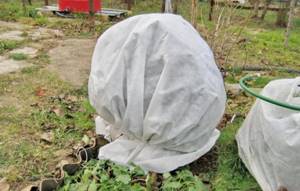
Main diseases and pests
It is well known that berry crops that are weakened by unfavorable external factors or poor care are most often affected by diseases and plant parasites. As a rule, blueberries in home gardening conditions are affected by gray mold or botrytis, anthracnose and coccomycosis. For the purpose of prevention, we can recommend purchasing and planting absolutely healthy planting material, as well as following the rules of planting and pruning berry bushes with the removal of diseased and weak shoots.
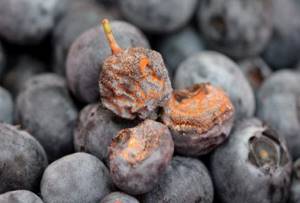
A prerequisite for growing garden blueberries is preventive treatment with folk remedies or special insectofungicides. For the purpose of protection, berry plantings can be sprayed with Planriz, Fitosporin, Alirin-B, Gamair and Gliokladin. Preventive treatments with immunomodulators such as immunocytophyte, Zircon and Epin have proven themselves well.
If you follow agricultural practices, blueberry plantings practically do not require the use of strong chemicals, which allows you to obtain the most environmentally friendly and healthy harvest.
Collection and storage of berries
In mid-July it's time to harvest. Ripe berries are easily removed from the bush; the main thing is to avoid overripeness, otherwise the fruits will fall off on their own . For complete ripening, after the fruit turns blue, you need to give it a couple more days so that the pulp becomes softer and gains mass, only then can you harvest. The berries ripen evenly, and once a week is enough to collect.
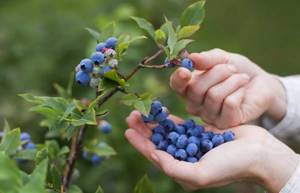
At room temperature, the berries quickly deteriorate, so they are immediately placed in the refrigerator, but even there the fruits retain their freshness for no more than two weeks. To keep the harvest as long as possible, the berries should be frozen. In this form they retain their beneficial properties until spring.
Beneficial properties of blueberries
Considering the chemical composition of blueberries, it becomes clear how nature has endowed the fruits of the plant with beneficial properties.
The berry contains:
- antioxidants (vitamin C), which help the body fight viral and inflammatory diseases;
- anthocyanins, which protect against the formation of cancer cells;
- manganese, which lowers blood sugar levels;
- vitamins B1, B2, PP, provitamin A - improve the elasticity of blood vessels;
- amino acids, iron, calcium, phosphorus are easily absorbed by the body.
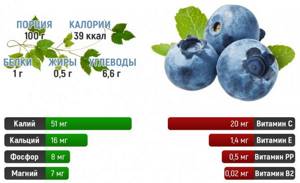
Fresh or frozen fruits help with gastrointestinal problems, diabetes, colds, and as a good antipyretic for fever. Long-term consumption of blueberries helps restore vision. The juice from the berries removes radioactive substances, and the tincture easily copes with dysentery and diarrhea.
The energy value of the product per 100 g is:
- calories - 57 kcal;
- proteins - 0.74 g;
- fats - 0.33 g;
- carbohydrates - 14.49 g;
- water - 84.21 g;
- ash –– 0.24 g.

Juices, decoctions, tinctures, fresh berries are beneficial for the body due to their chemical content, and are used both for the prevention of diseases and during treatment.
Contraindications
No matter how many berries you eat, you need to remember that everything is good in moderation. There are no special contraindications for consuming the product, but those suffering from high stomach acidity and those prone to allergies should try the berry with caution. You should not overeat, as you may experience a headache or vomit.
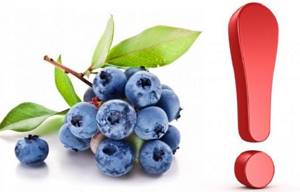
By planting garden blueberries on your plot, you will not only saturate your body with essential vitamins and take care of your health, but you will also be able to improve your plot with a beautiful plant. And since the plant is considered a long-liver (it can live up to 100 years), it will create an atmosphere of comfort in the country for a long time.
Seasonal decoration
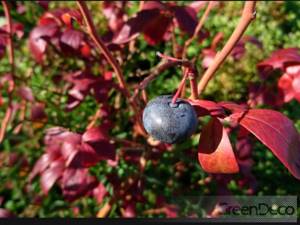
Although blueberries do an excellent job as a tapeworm, creating memorable accents that are hard to look away from, when landscaping, their unique beauty needs to be framed. In this regard, in landscape design, the tendency to group it with evergreen representatives of the flora - slender boxwood, elegant cherry laurel, and sophisticated butcher - has become firmly established.
Since breeders are successfully able to vary the habit of garden blueberries, this opens up significant prospects in terms of combination. Medium-sized specimens are very successful in the now fashionable heather gardens, paired with Kalmia angustifolia. The white note started by blueberries during flowering can be continued by pieris - their inflorescences perfectly match in shape.
By the way, low-growing varieties of blueberries will come in handy in large-scale mixborders with conifers. But in order to maintain proportionality, landscape designers recommend that there be equal numbers of blueberry and conifer specimens.

